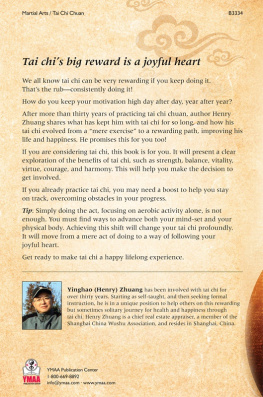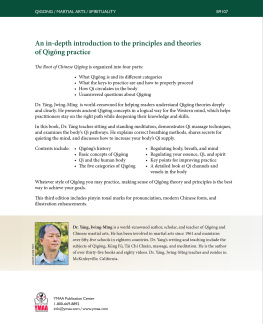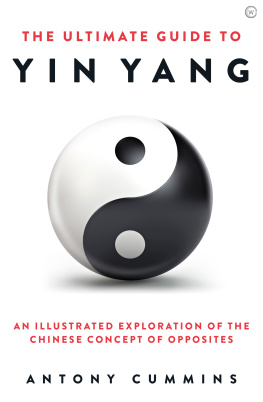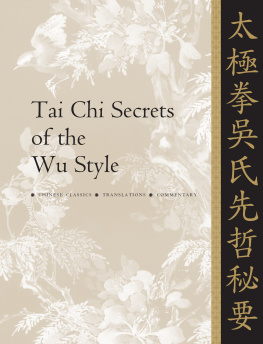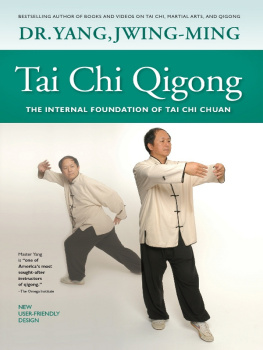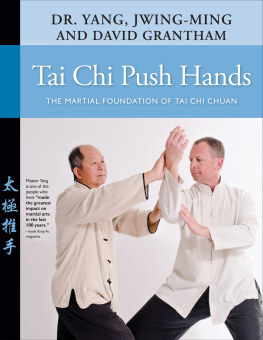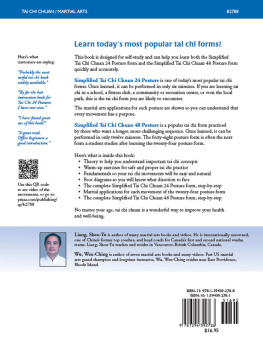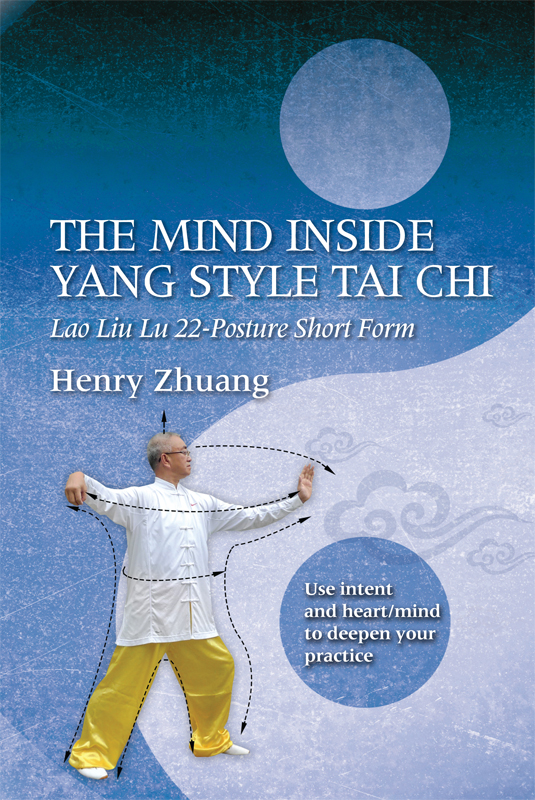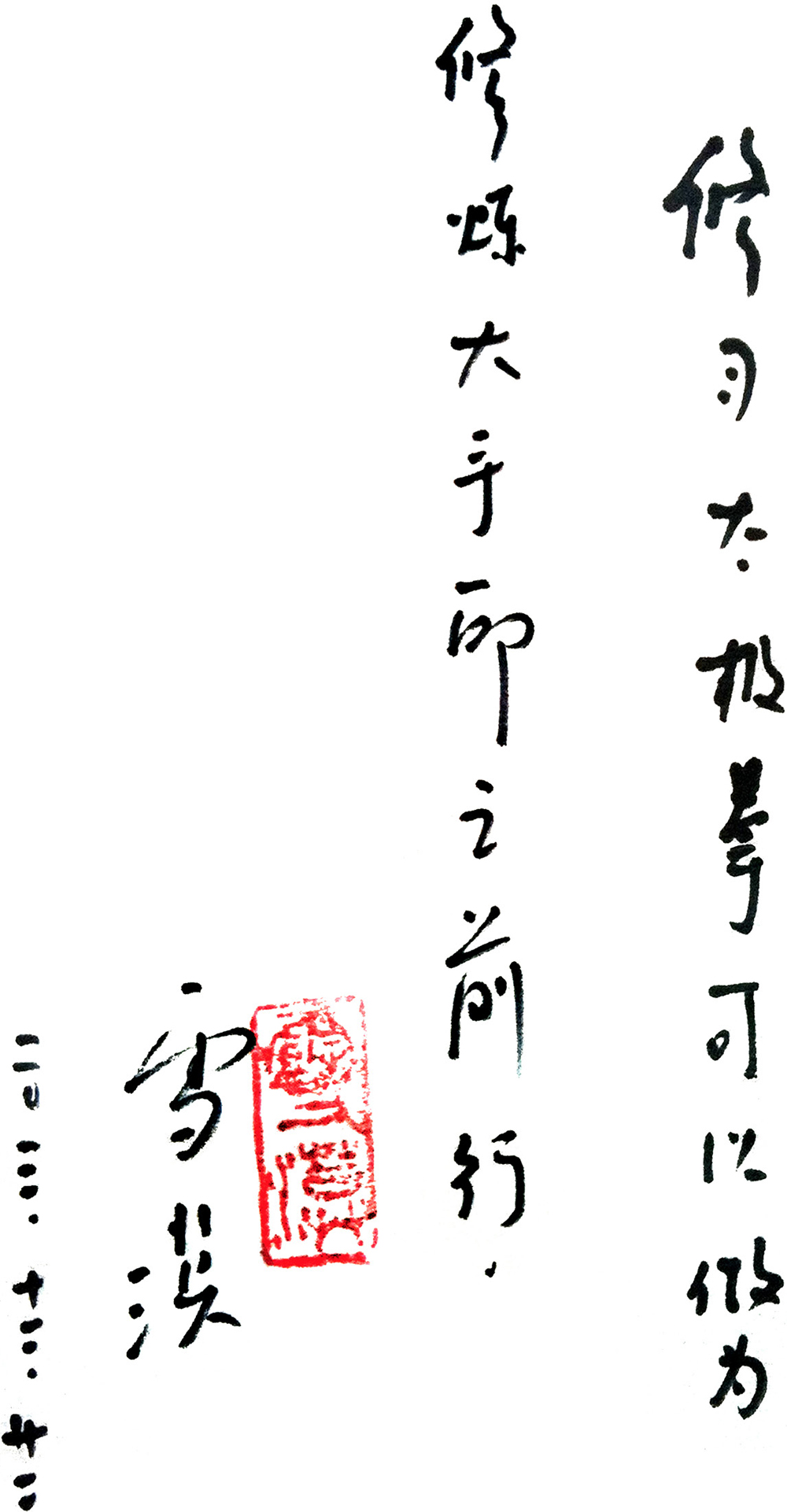Contents
Guide
Pagebreaks of the print version
THE MIND INSIDE YANG STYLE TAI CHI
Lao Liu Lu 22-Posture Short Form
Henry Zhuang
YMAA Publication Center
Wolfeboro, NH USA
YMAA Publication Center, Inc.
Main Office:
PO Box 480
Wolfeboro, New Hampshire 03894
1-800-669-8892
ISBN: 9781594393532 (print) ISBN: 9781594393549 (ebook)
All rights reserved including the right of reproduction in whole or in part in any form.
Copyright 2016 by Yinghao (Henry) Zhuang
Edited by Leslie Takao
Cover design by Axie Breen
Photos by the author unless noted otherwise
Publishers Cataloging in Publication
Names:
Zhuang, Henry.
Title:
The mind inside Yang style tai chi : lao liu lu 22-posture short form / Henry Zhuang. -
Description:
Wolfeboro, NH USA : YMAA Publication Center, [2016] | Includes bibliographical references, glossary and index. | Contents: Introduction of Yang-style lao liu lu taijiquan -- The mind approach of Yang-style lao liu lu (twenty-two form) taijiquan.
Identifiers:
ISBN: 978-1-59439-353-2 (print) | 978-1-59439-354-9 (ebook)
Subjects:
LCSH: Tai chi. | Tai chi--Psychological aspects. | Tai chi--Health aspects. | Yang, Chenfu, 1883-1936. | Mind and body. | Body-mind centering. | Qi (Chinese philosophy) | Martial arts. | BISAC: SPORTS & RECREATION / Martial Arts & Self-Defense. | BODY, MIND & SPIRIT / Healing / Energy (Qigong, Reiki, Polarity) | HEALTH & FITNESS / Exercise.
Classification:
LCC: GV504 .Z584 2016 | DDC: 613.7/148--dc23
The practice, treatments, and methods described in this book should not be used as an alternative to professional medical diagnosis or treatment. The author and the publisher of this book are NOT RESPONSIBLE in any manner whatsoever for any injury or negative effects that may occur through following the instructions and advice contained herein.
The activities, physical or otherwise, described in this manual may be too strenuous or dangerous for some people. It is recommended that before beginning any treatment or exercise program, you consult your medical professional to determine whether you should undertake this course of practice.
Learning and practicing taijiquan can serve as the preparation of learning Mahamudra.
Xue Mo
Dec. 12, 2012
Xue Mo is a famous Chinese writer, the vice chairman of Gansu Authors Guild, and a research expert of Mahamudra. He is known as the father of contemporary Mahamudra research.
Contents
This book was compiled by my friend Henry Zhuang. Taijiquan, a Chinese wushu, is the essence of five thousand years of Chinese culture. It is a reflection of the Chinese understanding that everything in the world consists of positive and negative materials. Taiji is integrity, the quality of being a gentleman, like Dao models itself after nature and the created universe carries the yin at its back and yang in front. Use the mind approach to practice, the mind to run the qi, and let qi move the body. With both the mind and body following the intent, one can prolong life and develop wisdom.
Huang Zhao Qiang
Chairman of Shanghai Wushu
In the time of Qing dynasty, taijiquan was quite popular in the royal palace due to Prince Pu Lun Bei Zi, a man of great power and wealth, who appreciated the fighting technique of Yang-style taijiquan. He recognized the martial applications disguised in the slow, graceful movements, as if there were needles hidden, wrapped in cotton. He invited Yang Jian Hou (third son of Yang Lu Chancreating master of Yang-style taijiquan) into his mansion to teach and offered generous reward and favor, which influenced the Yang family to share their secrets of gongfu and taijiquan and to teach the traditional internal power that is usually called Lao Liu Lu or Old Six Routines. However, it was Wang Chong Lu, a housekeeper and servant of Prince Lun, and his son who actually went into deep study and developed the deep understanding needed to inherit the internal power and technique. This became the bloodline thriving in the capital for the internal power and mind approach.
It is said, Wang Chong Lu, when formally acknowledging Yang as master, was instructed by Yang, What I teach you [the mind approach of the internal power] shall not be released outside, except to your son. That is the Yangs livelihood, and you do not want to ruin [it]. Wang and his son kept their word and never released any of the secrets of the mind approach of internal power. It was not until the 1990s, the third anniversary of Wang Yong Quans passing, that True Essence of Yang Style Taijiquan was released to the public. In it he described, in detail, the essence of Yang-style Lao Liu Lu. It is a true classic of Yang style, which is the great achievement and contribution of Wang Yong Quan in his later years.
In 1982 Wei Shu Ren was formally accepted as a disciple of Wang Yong Quan. Wei was an adept student and gained favor from Wang, and took the instruction left by Wang to write books and accept disciples to promote Yang style. True Essence of Yang Style Taijiquan and Yang Jian Hous Private Teaching of Authentic Internal Power were published in 1999 and 2000 respectively. They revealed the true essence of Yang-style Lao Liu Lu, for which we are fortunate, as the art was endangered due to the veil of secrecy kept by the masters of previous generations. It is a great contribution for human health.
Key Representatives
Yang JianThe Second-Generation Master, Creating Master of Lao Liu Lu
Yang Jian (18391918), style name Jian Hou and also known as Jinghu, was called Gentleman Three by people, and Old Gentleman in his later years. A style name was given to imply a particular virtue. Yang Jian Hou was born with a subtle tranquility, a nature recognized by his father, Yang Lu. This subtle tranquility is an ability to abide or rest in the natural mind, or in Buddhism, in the Buddha nature. Persons born with this subtle tranquility are prime material for Dao cultivation and practicing internal boxing. He believed it would be Yang Jian Hou who would take the lead in the Yang family.
When he was practicing gongfu with his father, he completed all of his fathers teachings, including more than ten complete forms, swords and spears, internal and external power training, concealed weapons, and shooting. The painstaking training was unbearable for most people, but was the key to Yangs ultimate exquisite gongfu. His boxing style couples both strength and gentleness, which is truly the ultimate realm, with mastery of sword, saber, spear, and pole. Many martial artists from other schools, skilled at sword and saber, challenged Yang, and all were beaten as if they were flies brushed away with a fly whisk. He was also skilled at spear and pole, capable of applying all kinds of forces to the tip of the pole. Therefore, when other spear or pole martial artists confronted him, they were all thrown away. He was an expert in shooting as well, and accurate every time. With three or four stones at hand, he could shoot down birds of the same number. What was unbelievable was his skill of holding a bird in the open palm of his hand and through sensitivity to the birds motion prevented it from flying away.


